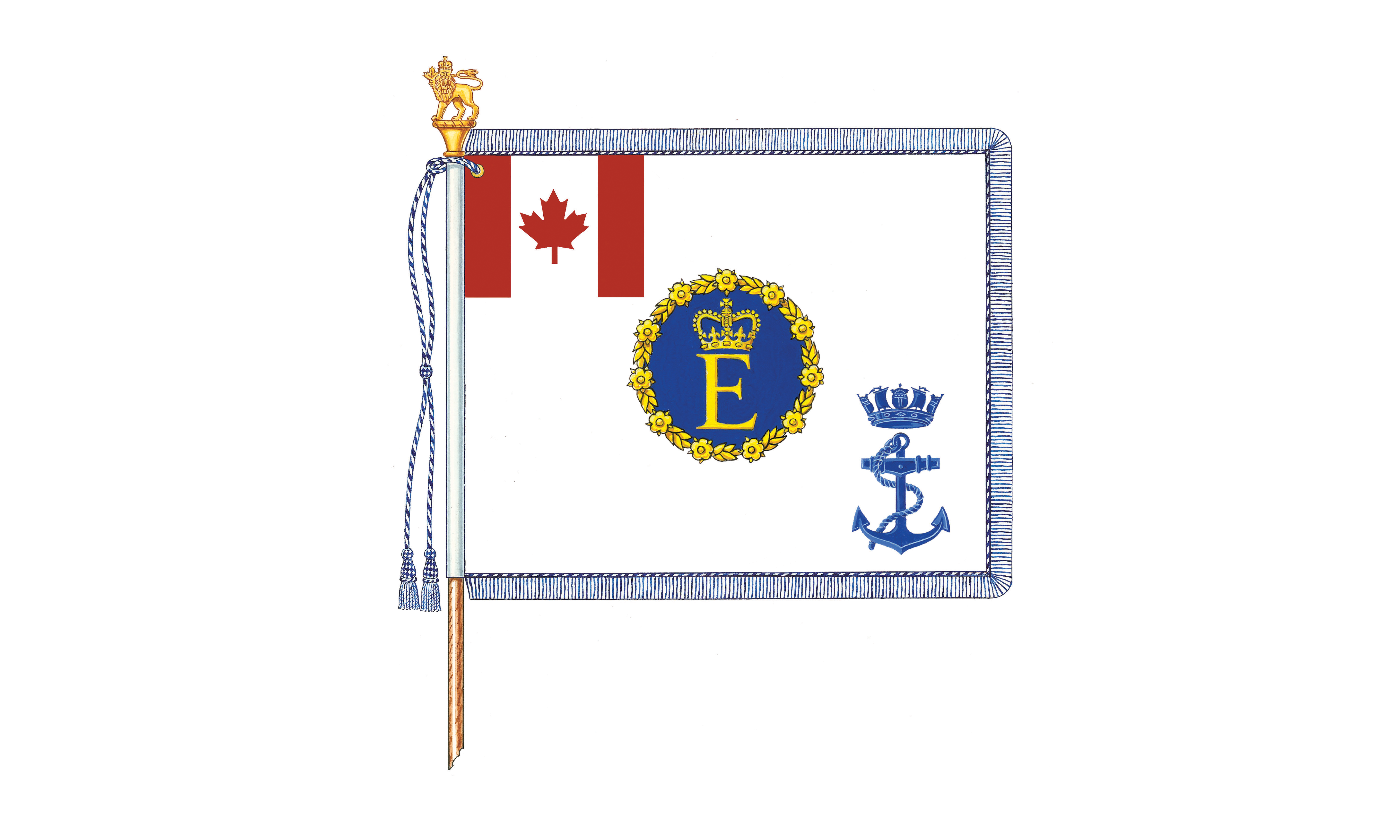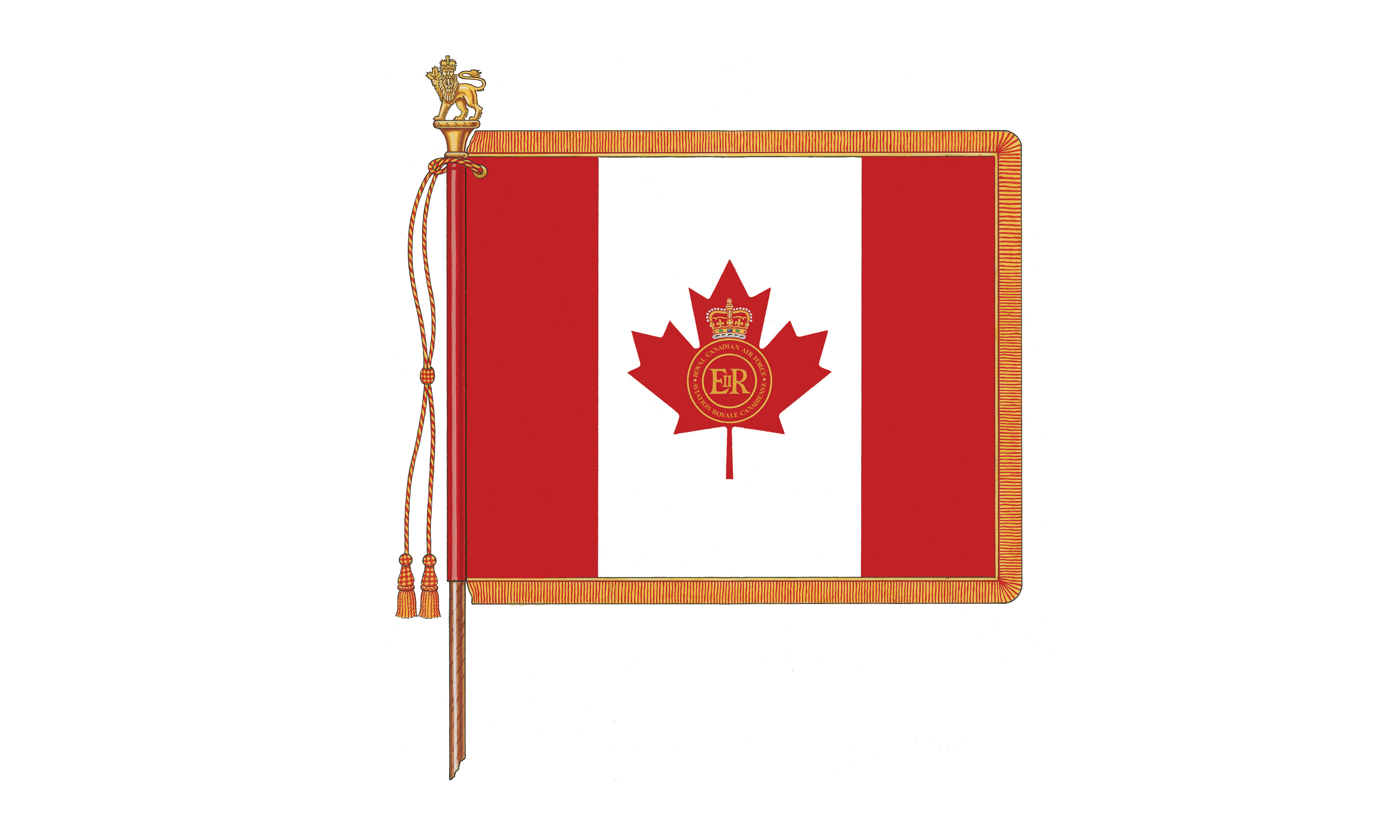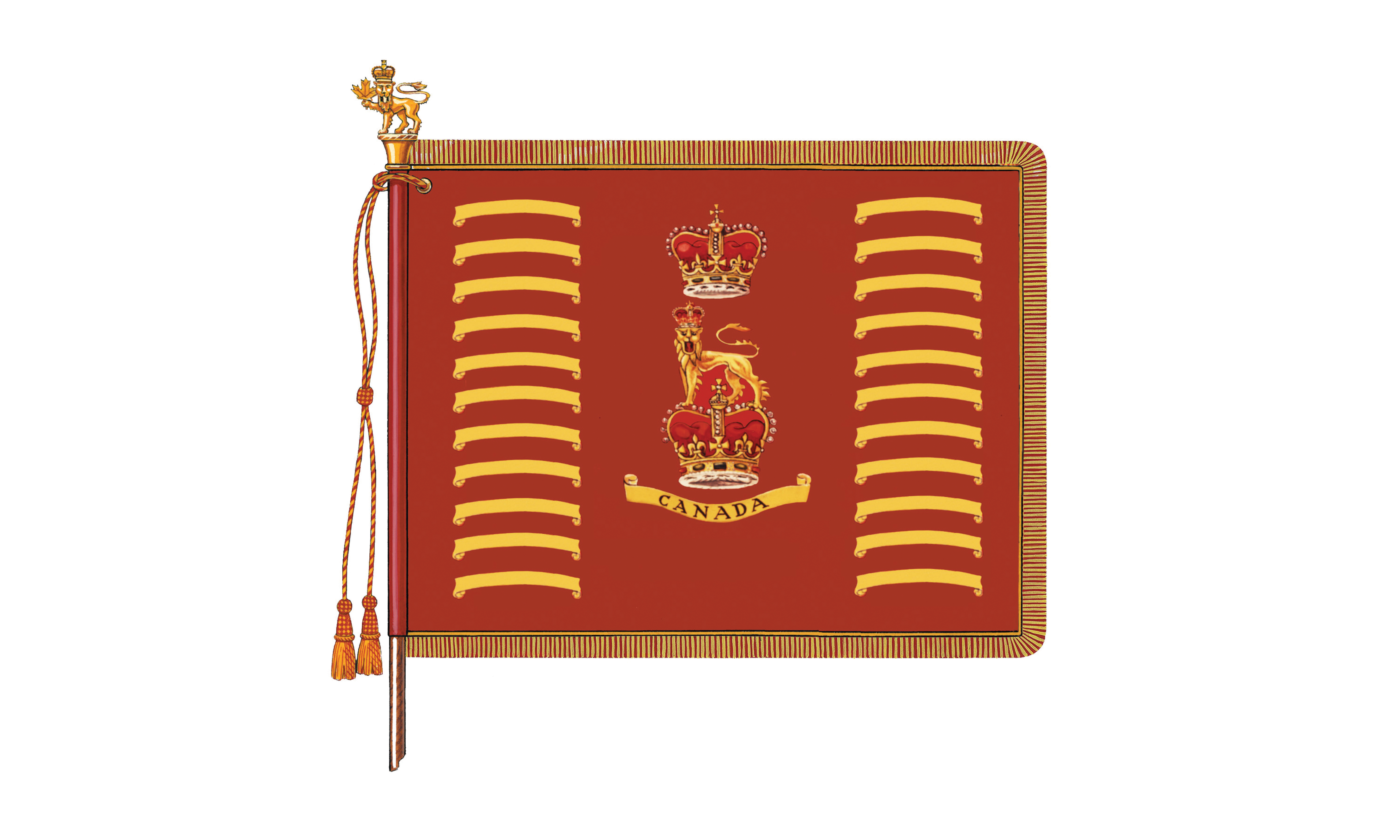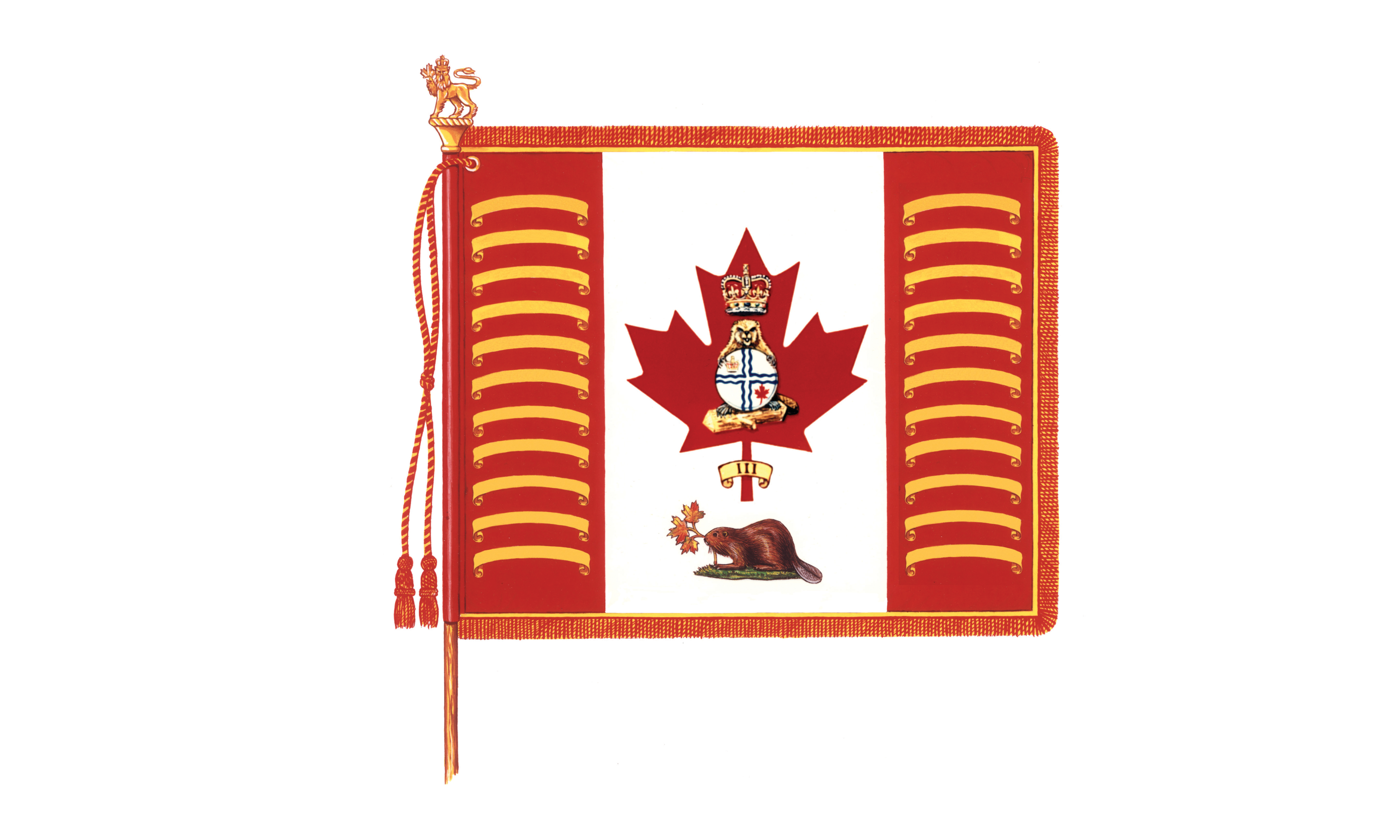Heritage Structure | Annex A – The design of standards, guidons and colours
- Annex A – The design of standards, guidons and colours (5A-1)
- General (5A-1)
- Procedure (5A-1)
- Battle honours (5A-1)
- Honorary distinctions (5A-2)
- Language (5A-2)
- Armour Regiment standards and guidons (5A-2)
- Royal Military College and Infantry/Airborne Queen's and regimental colours (5A-4)
- Differentiating multiple unit regiments (5A-5)
- Flying squadron standards (5A-6)
- Displaying colours (5A-6)
GENERAL
- Colour designs follow functional patterns for instant recognition. The patterns are illustrated and annotated, where necessary, in figures 5A-1 to 5A-15. Detailed specifications are held by National Defence Headquarters (NDHQ)/Director History and Heritage (DHH), which arranges for manufacture. Design variations are noted below.
THE CROWN AND ROYAL CYPHER
- The design of the St. Edward’s Crown and the Royal Cypher, "EIIR", shall be used wherever these devices are authorized on Colours. Only the Royal Cypher of the reigning Sovereign will be approved for new Colours.
BATTLE HONOURS
- Battle honours are displayed on unit Colours. The maximum numbers which can be emblazoned are noted in Chapter 3, Section 2.
- The same honours will be displayed on the Colours of all units of a regiment. (Militia regiments which bear the designation of a Regular Force regiment as a secondary title only are separate units and display only their own honours on their Colours.)
- Battle honours are emblazoned and duplicated on both the obverse and reverse sides of a Colour, in their established order as seen on both sides. See Chapter 3, Section 2, paragraph 27. A final odd-numbered honour is placed in the centre below any motto and above any honorary distinction authorized to be included in the lower centre of the design. Battle honours are emblazoned on both the Queen’s Colour and the regimental Colour of foot guards and on the regimental Colour only of other infantry units.
HONORARY DISTINCTIONS
- Badges and devices awarded as honorary distinctions usually will be displayed below the central device and any other device and distinction on the regimental Colour/squadron Standard or battle honour board. An honorary distinction specifically awarded to a battalion of a regiment will be displayed on the Colour of that battalion only.
LANGUAGE
- Battle honours on flying squadron Standards shall be displayed in both official languages. Regiments are entitled to emblazon honours in the language of their regimental title. If their title is bilingual – for example, the former Canadian Airborne Regiment/Régiment aéroporté du Canada (now disbanded) – honours shall be emblazoned in both official languages.
NOTE
Current Colours are historic artifacts and shall not be changed to include bilingual battle honours. Necessary changes will take place during the normal replacement process (see Section 1), or when specifically authorized by NDHQ/DHH (Inspector of CAF Colours and Badges).
ARMOUR REGIMENT STANDARDS AND GUIDONS
- Standards and Guidons are of crimson silk damask, embroidered and fringed with gold. Tassel and cords are of crimson silk and gold cord mixed.
- Standards are 75 cm flying and 66 cm deep on the lance, exclusive of the fringe which is about 5 cm in length. The corners of the Standards are square (see Figure 5A-4).
- Guidons are 105 cm flying to the ends of the points of the swallowtail and 69 cm deep on the lance, exclusive of the fringe which is about 5 cm in length. The upper and lower corners of the Guidon are rounded off at 30 cm from the end. The point of the slit is 79 cm from the lance and equidistant from the upper and lower edges. The width of the slit at the point of the swallowtail is 34 cm (see figures 5A-5 and 5A-6).
- The Standard or Guidon of each unit will bear, unless otherwise authorized, the Royal or other title in letters of gold on a crimson circle, in the centre of a wreath of autumnal tinted maple leaves ensigned with the Crown, and, within the circle, a badge, selected by the unit and approved by NDHQ/DHH (Inspector of CAF Colours and Badges). By custom, cavalry regiments authorized to bear the Garter as a distinction substitute this for the crimson circle and regimental title.
- The Standards and Guidons of armour regiments, which formerly were cavalry, contain the White Horse of Hanover on a green mount on a crimson ground within a scroll in the first and fourth quarters (see Figure 5A-5). The rank (now, an abbreviated title of the regiment) or other authorized device, on a ground of the colour of the facings of the regiment, is placed in the second and third quarters within a wreath of autumnal tinted maple leaves. The devices, distinctions (including battle honours approved for emblazonment) and any approved motto, are also borne on the Standard or Guidon. A motto, if included, is inscribed upon a scroll placed on the tie at the centre of the main wreath.
- On the Guidon of armour regiments with no cavalry background, the White Horse of Hanover will be replaced by a white ram on a green mount on a crimson ground (see Figure 5A-6). In a few specific cases, other substitutions may be allowed.
- Armour regiments with more than one unit differentiate their Standards or Guidons as described in paragraphs 25 and 26.
ROYAL MILITARY COLLEGES AND INFANTRY QUEEN’S AND REGIMENTAL COLOURS
- The Queen’s and regimental Colours of the Royal Military Colleges of Canada and infantry units are of silk, with cords and tassels of mixed gold and crimson silk. On the Queen’s Colour, the fringe is of gold and crimson silk, and on the regimental Colour, the fringe is of silk in gold and the facing colour of the regiment.
- The dimensions of Colours are 114 cm flying and 91 cm deep on the pike, exclusive of the fringe which is about 5 cm in length.
- The Queen’s Colour for regiments of foot guards is crimson. This Colour bears the badges and distinctions, including battle honours, conferred on the respective regiments. The badge is borne on the centre of the Queen’s Colour, ensigned by the Crown (see Figure 5A-7). In multi-battalion regiments of foot guards, the Colour of the additional units will be differentiated as described in paragraphs 24 to 26.
- The Queen’s Colour for other infantry units and the Royal Military Colleges of Canada is based on the National Flag. This Colour bears in the centre the authorized designation on a red circle, with the battalion numeral within, if required, the whole is ensigned by the Crown (see Figure 5A-8).
- The regimental Colour for regiments of foot guards is the National Flag. This Colour bears the approved badges and distinctions including battle honours. In those regiments where badges have been conferred on each of the companies comprising the respective battalions, the company badges are borne in the centre of the regimental Colours in rotation as the Colours are renewed. In each case, the company number is displayed on a scroll below the badge. In multi-battalion foot guard regiments, the battalion numeral is borne in the upper canton of each regimental Colour, next to the pike (see Figure 5A-9).
- The regimental Colour of a line infantry unit is the colour of the authorized facings. Although when the facings are scarlet, white or black, the regimental Colour is the Red Cross of St. George. This is charged on a white ground if the facings are scarlet or white, or on a black ground if the facings are black.
- A college or regimental Colour usually employs the complete or main device from the college or regimental badge as the central badge. The regimental Colour may also bear approved badges, devices and distinctions, including battle honours and mottoes. The battalion numeral, if required, is placed in the upper canton, but below any honorary distinction which the unit is entitled to bear in that upper canton. The title of the regiment is inscribed on a crimson circle placed within a wreath of autumnal tinted maple leaves, with a badge, selected by the regiment and approved by NDHQ/DHH (Inspector of CAF Colours and Badges), on a crimson ground in the centre, the whole ensigned with the Crown (see Figure 5A-10). For military college Colours, the wreath is of gold tinted maple leaves. In those units with more than nine battle honours approved to be borne on the regimental Colour, laurel branches encircling the wreath of maple leaves are introduced, and the scrolls bearing the battle honours are placed on the branches (see Figure 5A-11). The motto of the regiment, if one is approved, is inscribed on a scroll placed upon the tie of the wreath of maple leaves.
- Regiments with scarlet, white or black facings will carry a regimental Colour of the design in Figure 5A-12.
- For highland regiments, the wreath within which the crimson circle is placed will alternate autumnal tinted maple leaves and thistles. See Figure 5A-13.
DIFFERENTIATING MULTIPLE UNIT REGIMENTS
- In British custom, the use of a national flag to show allegiance can be traced to 1385 when King Richard II directed in his Statutes and Ordinances of War that "Everyman of what estate, condition or nation he may be, so that he be of our party, shall bear a large sign of the Arms of St. George before and another behind, ..." By the end of the sixteenth century European armies began to follow a more systematic approach to formation identification and by 1643, company Colours in the English Parliamentary Forces were differentiated by the St. George’s Cross and various devices such as lozenges, piles-wavy, talbots. Modern Canadian military custom draws upon this heritage.
- Colours for multiple unit regiments, with the exception of line infantry Colours and regimental Colours for regiments of foot guards (see paragraphs 19 to 22), are differenced with the National Flag and gold piles-wavy – heraldic devices representing rays of sunlight – emanating from the upper dexter canton and radiating towards, but not touching, the central device (see Figure 5A-14).
- The National Flag shall replace all devices in the first quarter and shall be emblazoned on the Colours of second and additional units of a regiment mentioned in paragraph 25 above. Gold piles-wavy are to be emblazoned in the appropriate number on the Colours of the third and additional unit of a regiment mentioned in paragraph 25 above. (Existing duplicate Colours are historic artifacts and will not be replaced until worn out.)
FLYING SQUADRON STANDARDS
- The flying squadron Standard is a rectangular double silk flag, embroidered on both sides, 81 cm on the staff and 122 cm in the fly, exclusive of the fringe which is of gold and light blue silk and about 5 cm in length. The Standard is light blue in colour and has a border composed of 14 floral emblems coloured silk embroidery representing the ten provinces and three territories of Canada. The fourteenth floral emblem is a maple leaf. In the centre is the unit badge. On either side of the badge are bilingual battle honours inscribed in black on white scrolls (see paragraph 7). When an odd number of battle honours are displayed, one honour is placed in the centre below the unit badge and above any honorary distinction (see Figure 5A-15).
DISPLAYING COLOURS
- The method of displaying a single or a stand of Colours is as illustrated in Section 1, figures 5-1-1 and 5-1-2.

Figure 5-a-1 Queen’s Colour: Royal Canadian Navy

Figure 5-a-2 Queen’s Colour: Royal Canadian Air Force

Figure 5-a-3 Command Colour: Royal Canadian Air Force

Figure 5-a-4 Standard: Horse Guards and Dragoon Guards

Figure 5-a-5 Guidon: Other Armour Regiments (Former Cavalry)

Figure 5-a-6 Guidon: Armour Regiments (Without a Cavalry Background)

Figure 5-a-7 Queen’s Colour: Foot Guards

Figure 5-a-8 Queen’s Colour: Infantry Regiments (Except Foot Guards)

Figure 5-a-9 Regimental Colour: Foot Guards

Figure 5-a-10 Regimental Colour: Infantry Regiments (Except Foot Guards and Highland) with less than 10 Battle Honours

Figure 5-a-11 Regimental Colour: Infantry Regiments (Except Foot Guards and highland) with 10 or more Battle Honours

Figure 5-a-12 Regimental Colour: Infantry Regiments (Except Foot Guards and Highland) with White, Black or Scarlet Facings

Figure 5-a-13 Regimental Colour: Highland Regiments

Figure 5-a-14 Armour Regiments Standards and Guidons and Queen’s Colours for Regiments of Foot Guard: Multi-Unit Regiments

Figure 5-a-15 Standard : Air Squadron